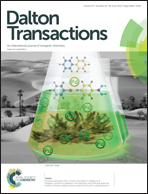Photoluminescence and EPR studies on Fe3+ doped ZnAl2O4: an evidence for local site swapping of Fe3+ and formation of inverse and normal phase
Abstract
Considering that ZnAl2O4 spinel has two different sites (octahedral and tetrahedral) and its properties change with dopant ion distribution among these two sites; ZnAl2O4 doped with varied concentrations of Fe3+ was synthesized by a low temperature sol–gel combustion method. Phase purity and structural investigations were carried out using Rietveld refined X-ray diffraction which shows a decrease in the value of cell parameters at higher doping levels. Photoluminescence (PL) and electron paramagnetic resonance (EPR) studies have shown that on doping, Fe3+ ions were distributed in both tetrahedral and octahedral sites. At octahedral sites, Fe3+ exhibited a broad red emission around 745 nm while at tetrahedral sites it exhibited well-defined vibronic sidebands at 665, 674, 684 and 693 nm along with a broad blue band with a maxima at 445 nm at room temperature. EPR studies have shown a broad spectrum at g ≈ 2.2 which corresponds to the Fe3+ in octahedral sites, while the broad signal at g ≈ 4.2 belongs to Fe3+ in tetrahedral sites. It was also inferred from these studies that Fe3+ prefers to occupy octahedral sites at higher concentrations and at higher annealing temperatures. The PL decay behavior of Fe3+ in ZnAl2O4 has also shown that two different types of Fe3+ ions were present in this matrix. The first type was a long lived species (τ ≈ 170 μs) present at octahedral sites and the other was a short lived species (τ ≈ 40 μs) present at the tetrahedral sites; the fraction of the long lived species predominate at higher concentrations. Thus the present work is mainly focused on understanding the tuning of local site occupancy of the dopant ion among those sites with varying concentration and annealing temperature, using the dopant ion itself as a spectroscopic probe, which further helps in understanding the phase (inverse and normal) of the spinel.


 Please wait while we load your content...
Please wait while we load your content...